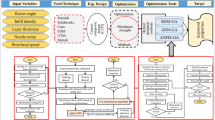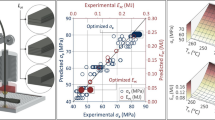Abstract
Composite materials are widely employed in various industries, such as aerospace, automobile, and sports equipment, owing to their lightweight and strong structure in comparison with conventional materials. Laser material processing is a rapid technique for performing the various processes on composite materials. In particular, laser forming is a flexible and reliable approach for shaping fiber-metal laminates (FMLs), which are widely used in the aerospace industry due to several advantages, such as high strength and light weight. In this study, a prediction model was developed for determining the optimal laser parameters (power and speed) when forming FML composites. Artificial neural networks (ANNs) were applied to estimate the process outputs (temperature and bending angle) as a result of the modeling process. For this purpose, several ANN models were developed using various strategies. Finally, the achieved results demonstrated the advantage of the models for predicting the optimal operational parameters.








Similar content being viewed by others
References
Gisario A, Mehrpouya M, Venettacci S et al (2016) Laser Origami (LO) of three-dimensional (3D) components: experimental analysis and numerical modelling. J Manuf Process 23:242–248
Edwardson S, Abed E, Carey C et al (2007) Key factors influencing the bend per pass in laser forming. In: International congress on applications of lasers & electro-optics, 2007, p 506
Gisario A, Mehrpouya M, Venettacci S et al (2017) Laser-assisted bending of titanium grade-2 sheets: experimental analysis and numerical simulation. Opt Lasers Eng 92:110–119
Mehrpouya M, Huang H, Venettacci S et al (2019) LaserOrigami (LO) of three-dimensional (3D) components: experimental analysis and numerical modeling-part II. J Manuf Process 39:192–199
Gisario A, Barletta M (2018) Laser forming of glass laminate aluminium reinforced epoxy (GLARE): on the role of mechanical, physical and chemical interactions in the multi-layers material. Opt Lasers Eng 110:364–376
Asundi A, Choi AY (1997) Fiber metal laminates: an advanced material for future aircraft. J Mater Process Technol 63:384–394
Vlot A, Vogelesang L, De Vries T (1999) Towards application of fibre metal laminates in large aircraft. Aircr Eng Aerosp Technol 71:558–570
Le Bourlegat L, Damato C, Da Silva D et al (2010) Processing and mechanical characterization of titanium-graphite hybrid laminates. J Reinf Plast Compos 29:3392–3400
Zhang Q, Huang JQ, Qian WZ et al (2013) The road for nanomaterials industry: a review of carbon nanotube production, post-treatment, and bulk applications for composites and energy storage. Small 9:1237–1265
Hassani M, Hassani Y, Ajudanioskooei N et al (2017) Comparative study of bending angle in laser forming process using artificial neural network and fuzzy logic system. World Acad Sci Eng Technol Int J Math Comput Phys Electr Comput Eng 9:595–598
Selvakumar N, Ganesan P, Radha P et al (2007) Modelling the effect of particle size and iron content on forming of Al-Fe composite preforms using neural network. Mater Des 28:119–130
Mishra R, Malik J, Singh I et al (2010) Neural network approach for estimating the residual tensile strength after drilling in uni-directional glass fiber reinforced plastic laminates. Mater Des 31:2790–2795
Jiang HJ, Liang LH, Xiao YL et al (2018) Three-dimensional transient thermodynamic analysis of laser surface treatment for a fiber laminated plate with a coating layer. Int J Heat Mass Transf 118:671–685
Jiang HJ, Liang LH, Ma L et al (2017) An analytical solution of three-dimensional steady thermodynamic analysis for a piezoelectric laminated plate using refined plate theory. Compos Struct 162:194–209
Mehrpouya M (2017) Laser welding of NiTi shape memory sheets: experimental analysis and numerical modeling. Dissertation, Sapienza University of Rome
Mehrpouya M, Shahedin AM, Daood SDS et al (2017) An investigation on the optimum machinability of NiTi based shape memory alloy. Mater Manuf Process 32(13):1497–1504
Mehrpouya M (2013) Modeling of machining perocess of nickel based shape memory alloy. Dissertation, Universiti Putra Malaysia
Mehrpouya M, Gisario A, Rahimzadeh A et al (2019) An artificial neural network model for laser transmission welding of biodegradable polyethylene terephthalate/polyethylene vinyl acetate (PET/PEVA) blends. Int J Adv Manuf Technol 102(5/8):1497–1507
Mehrpouya M, Gisario A, Rahimzadeh A et al (2019) A prediction model for finding the optimal laser parameters in additive manufacturing of NiTi shape memory alloy. Int J Adv Manuf Technol 105:4691–4699
Hajian A, Styles P (2018) Prior applications of neural networks in geophysics. In: Application of soft computing and intelligent methods in geophysics. Springer, Cham, pp 71–198
Lourakis M, Argyros A (2004) The design and implementation of a generic sparse bundle adjustment software package based on the levenberg-marquardt algorithm. Technical report 340, Institute of Computer Science-FORTH, Heraklion, Crete
Levenberg K (1944) A method for the solution of certain non-linear problems in least squares. Q Appl Math 2:164–168
Marquardt DW (1963) An algorithm for least-squares estimation of nonlinear parameters. J Soc Ind Appl Math 11:431–441
Moré JJ (1978) The Levenberg-Marquardt algorithm: implementation and theory. In: Numerical analysis. Springer, Berlin, Heidelberg, pp 105–116
Mehrpouya M, Gisario A, Huang H et al (2019) Numerical study for prediction of optimum operational parameters in laser welding of NiTi alloy. Opt Laser Technol 118:159–169
Akbari M, Saedodin S, Panjehpour A et al (2016) Numerical simulation and designing artificial neural network for estimating melt pool geometry and temperature distribution in laser welding of Ti6Al4V alloy. Optik 127:11161–11172
Author information
Authors and Affiliations
Corresponding author
Rights and permissions
About this article
Cite this article
Gisario, A., Mehrpouya, M., Rahimzadeh, A. et al. Prediction model for determining the optimum operational parameters in laser forming of fiber-reinforced composites. Adv. Manuf. 8, 242–251 (2020). https://doi.org/10.1007/s40436-020-00304-3
Received:
Revised:
Accepted:
Published:
Issue Date:
DOI: https://doi.org/10.1007/s40436-020-00304-3




